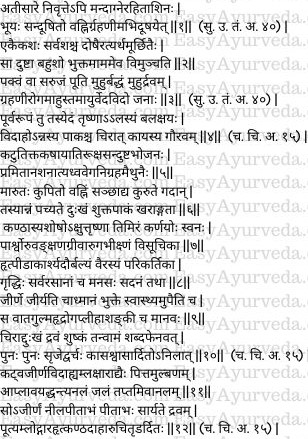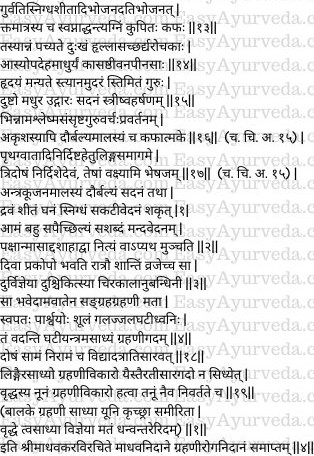Madhava Nidana Chapter 4 Grahani Roga Nidanam
In this article we are learning about Madava nidaana 4th chapter “Grahaniroga Nidaanam” – Disease of sprue or Irritable Bowel Syndrome.
Read – Acharya Madhavakara: His Work ‘Madhava Nidana’, Legacy, Amazing Facts

Table of Contents
Samprapti
Samprapti – Pathogenesis of Grahani Roga
Grahani disease occurs in persons who have been recently relieved of diarrhea but still have poor digestion (even others having poor digestion right from the beginning). When such persons indulge in unsuitable foods and activities, the doshas undergo increase. These doshas in turn affect the agni. This agni which has been contaminated by the doshas undergoes aggravation and affects the grahani (duodenum). (1)
Thus, the grahani gets excessively affected by the doshas either individually or in combination (individual dosha or combination of doshas). Such affected duodenum causes expulsion of most of the consumed food in an undigested or digested form. In this condition the faeces is foul smelling, sometimes hard (constipated) and sometimes fluid (diarrhoea) in nature and is accompanied with pain in the abdomen. Scholars of Ayurveda call this disease as Grahani Roga.(2-3)
Read – Charaka Grahani Dosha Chikitsa 15th Chapter
Grahani – chain of pathogenesis
- Person who has just (recently) been relieved from atisara (diarrhoea) but still has weak digestion strength
- Takes unsuitable foods and activities
- Abnormal increase in doshas
- Aggravated doshas afflict the agni (digestive fire)
- Agni disturbed due to contamination / affliction by doshas will further contaminate (afflict) the grahani (duodenum)
- Further the duodenum gets excessively affected by individual or combination of aggravated doshas
- The affected duodenum expels the food either in an undigested form or digested form
- The faeces smell foul and sometimes there is constipation and sometimes diarrhoea along with pain in the abdomen
- This disease is called as Grahani
Note – These chains of events happen in a similar way even in those who haven’t recovered from diarrhoea. These people have weak digestion from the beginning and in them the chronology of events of pathogenesis takes place in the same way explained here.
Read – IBS: Ayurvedic Treatment, Home Remedies, Lifestyle Tips
Purvarupa
Purvarupa – premonitory symptoms of Grahani
Premonitory symptoms of Grahani disease are – thirst, lack of enthusiasm, debility, improper digestion of food due to the action of weak digestive fire, delayed digestion of food and feeling of heaviness of the body.(4)
Vataja Grahani
Etiological factors, pathogenesis and symptoms of Vataja Grahani
Vata gets abnormally increased due to indulgence in foods which are pungent, bitter, astringent, dry, contaminated, and scanty or no food at all; too much of walk, suppression of natural urges of the body, excess sexual activities.
The vata thus increased destroys the agni – digestive fire and produces Vātaja Grahaņi Roga. Vataja Grahani Roga.
In this type of Grahani, the food gets digested with difficulty and undergoes fermentation. There also occurs hardness of the body parts, dryness of the throat and mouth, increased hunger and thirst, darkness before the eyes, noise in the ears, constant pain in the flanks, thighs, groins and neck; vomiting and diarrhea occur together, pain in the region of the heart, emaciation, weakness, bad taste in the mouth, cutting pain in the rectum / anal region, desire for foods of all the tastes, mental depression, distension of the abdomen after the digestion of food and during the period of digestion and feeling of comfort on taking food.
The patient gets suspicious of getting vāta gulma , hrid roga (disease of the heart), plīhā (splenic disorder), in future. (Alternatively, we can tell that the symptoms very much resemble those of vāta gulma – abdominal tumour, hrid roga – disease of the heart, pleeha – splenic disorder, causing difficulty in diagnosis).
Such a patient having cough and breathing trouble (dyspnoea, difficulty in respiration) repeatedly voids faeces after a long time, which is watery or dry, thin, frothy, improperly processed, accompanied with pain and noise. (5-10)
Read – Vata Dosha – Introduction, 40 Things To Know
Pittaja Grahani
Etiological factors, pathogenesis and symptoms of Pittaja Grahani
Pitta undergoes abnormal increase due to indulgence in foods which are pungent and uncooked, causing heartburn, sour and alkaline in nature. This increased pitta would activate the digestive fire just like the hot water poured over burning fire and produces pittaja grahaņi roga.
In this condition the patient will be eliminating faeces which are inadequately processed, bluish yellow or deep yellow in colour, watery and fetid. The person will have bad, sour belching; burning sensation in the chest and throat, loss of taste or appetite and thirst. (11-12)
Read – How To Balance Pitta Dosha? Line Of Treatment
Sanskrit Versus


Kaphaja Grahani
Etiological factors, pathogenesis and symptoms of Kaphaja Grahani
Kapha gets abnormally increased due to indulgence in foods which are heavy (hard to digest), too unctuous (oily), cold and taken excessively (frequently); and sleeping immediately after midday meal. This aggravated kapha destroys (inactivates) the digestive fire and causes kaphaja grahani disease.
In these patients the food gets digested with difficulty. He also would have nausea, vomiting, loss of taste (appetite), coating in the mouth (on the tongue), sweet taste in the mouth, cough, expectoration, running in the nose, heaviness of the heart, feeling as if the abdomen is filled with dense fluids, hardness (devoid of movements, tight), and heaviness of the abdomen, bad and sweet smelling belchings, debility and lack of interest in sex. The faeces is semi-solid, inadequately processed (associated with ama), mucous mixed and heavy. The patient is debilitated though not emaciated and is non-enthusiastic. (13-16)
Tridosaja Grahani
Etiological factors, pathogenesis and symptoms of Tridosaja Grahani
The presence of causes and symptoms of all the three doshas together is found in case of tridosha grahani roga. (17)
This means to say that tridoshaja grahani is caused in those who consume the etiological factors responsible for aggravation of all vata, pitta and kapha together. In this condition, the symptoms mentioned in vataja, pittaja and kaphaja grahani are present in combination (mixed up).
Read – Tridosha Theory in Ayurveda
Sangrahani Grahani
Sangrahani is marked by presence of gurgling sound in the intestines, laziness, weakness and malaise. In this condition the person excretes faeces which are liquid, cold, dense, and unctuous and associated with pain in the waist. The faeces which are inadequately processed (ama) is eliminated in large quantities, associated with slimy (sticky) material along with sounds and mild pain during excretion. These symptoms may appear once in 15, 30 or 10 days or even daily. The symptoms are pronounced during the day time and subside by night time. The nature of the disease cannot be understood easily, cannot be easily treated and persists for a long time. This condition is caused by vata associated with ama and is called sangraha grahani or samgrahani.
Ghatiyantra Grahani
This is also a variant of grahani disease. The person in this condition suffers from pain in the flanks while lying down and sounds resembling ‘that produced when a pot is dipped in the water’ are heard from the abdomen. This condition is incurable. (1-4)
Determination of ama and pakva states and signs of incurability of grahani
The determination of āma and pakva states of doshas and faeces in grahani disease shall be understood on the same lines as explained in the context of atisara (diarrhoea). The symptoms of incurability of grahani are the same as the symptoms of incurability of atisara. Grahaņī roga does not leave the old people without killing them. (18-19)
Read – Ama Chikitsa: Treatment For Ama And Saama Conditions
Prognosis
Prognosis of grahani roga – age wise
Grahaņī roga is easily curable in children, cured with difficulty in the middle-aged persons and incurable in the senile – thus opines Dhanwantari). (1)
Thus ends the chapter on Grahaņīroga of Madhava Nidana text, written by Acharya Madhavakara











